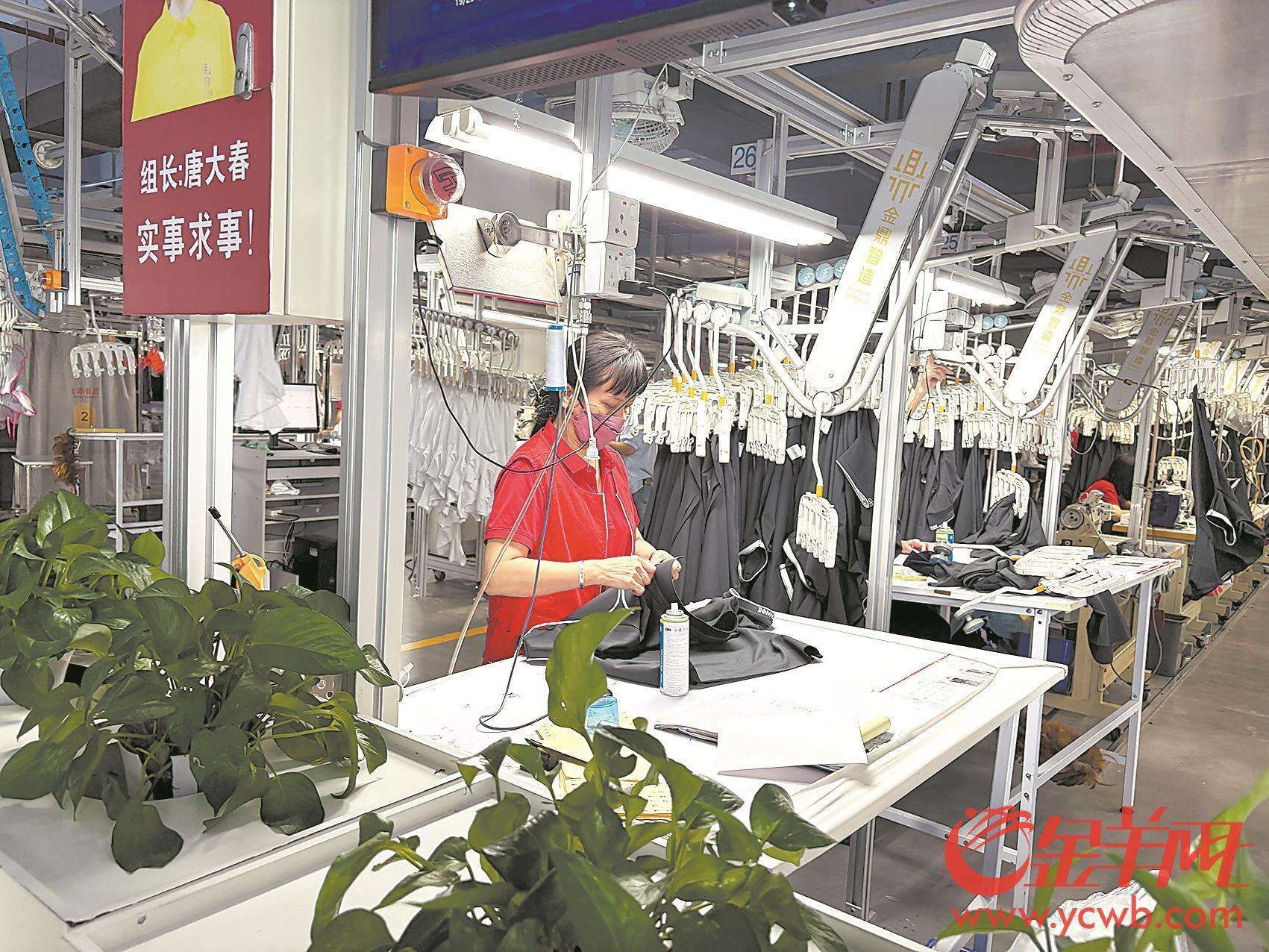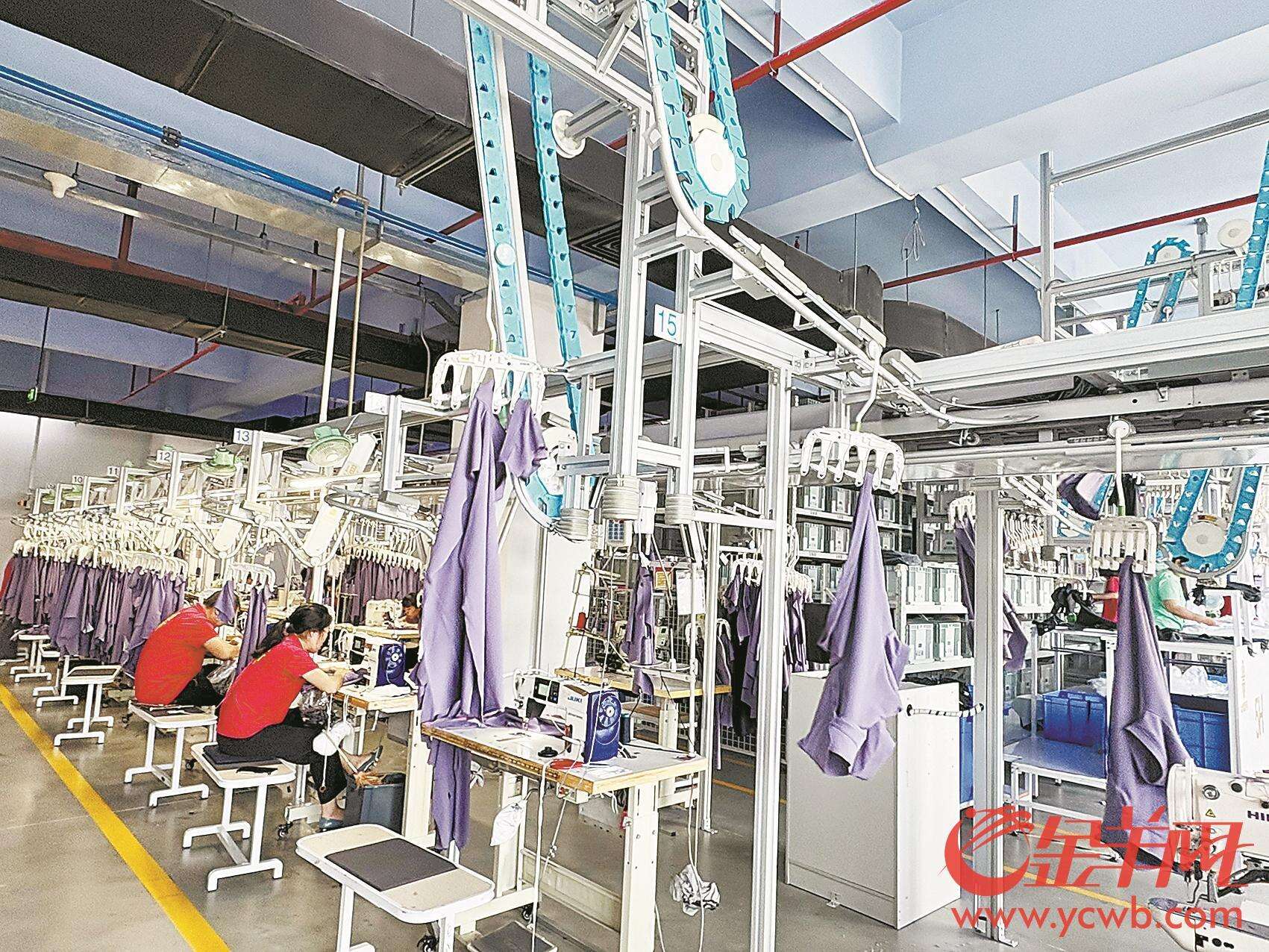This clothing company moved its fully automated assembly line into a five-star office building to attract Generation Z workers
While the traditional manufacturing industry in the Pearl River Delta is struggling in the wave of digital transformation and upgrading, thousands of garment companies in Shaxi, Zhongshan are experiencing a thrilling leap from the "sewing machine economy" to the "digital factory". In this important town of Chinese casual clothing, Guangdong Jinding Intelligent Manufacturing Clothing Technology Co., Ltd. (hereinafter referred to as "Jinding Intelligent Manufacturing") moved the fully automatic assembly line into a five-star office building. This "heresy" is like a scalpel, dissecting the deep texture of the breakthrough of labor-intensive industries - digital transformation is no longer a multiple-choice question, but a must-answer question related to survival. Deng Jun, general manager of Jinding Intelligent Manufacturing, told the Yangcheng Evening News all-media reporter in the intelligent clothing production workshop: "The secret to attracting Generation Z workers to the factory is hidden in the data port of each device. And this is also one of the driving forces for Jinding Intelligent Manufacturing to accelerate digital and intelligent transformation and upgrading."
 A neat, orderly and technologically advanced production scene
A neat, orderly and technologically advanced production scene
Breaking out of the cocoon: The awakening moment in the industry dilemma
Walking into the fashionable and modern office building of Jinding Intelligent Manufacturing, the five-story intelligent production workshop is actually hidden in it. The reporter saw that there was no noise and chaos of traditional factories here, but a neat, orderly and technological production scene instead. Standing in front of the large central control screen of Jinding Intelligent Manufacturing Workshop, Deng Jun's fingertips passed through the real-time production data - the yield rate fluctuation of each garment, the 90-meter hanging main track connecting the hanging piece to the garment with a daily flow of up to 24,000 pieces, and the fulfillment countdown of the full-link rapid reverse order. These concrete numbers are deconstructing the operating rules of the ancient industry of clothing manufacturing.
In Shaxi, Zhongshan, a "Chinese leisure clothing town" that gathers thousands of garment companies, Jinding Intelligent Manufacturing, which has been rooted in Shaxi for more than 20 years, took the lead in tearing open the iron curtain of traditional manufacturing: when its peers are still using paper work orders to dispatch workers, its digital workshop has achieved a subversive leap of 30% improvement in labor efficiency and 40% reduction in delivery cycle. In 2024, Jinding Intelligent Manufacturing will continue to explore the single-line multi-model production model, and a new floor of boutique workshop will be added in May to solve the industry pain points of complex styles and small order volumes in small orders and quick responses.
In the garden-style office on the top floor of Jinding Intelligent Manufacturing, Deng Jun told reporters about Jinding Intelligent Manufacturing's digital transformation path. "In fact, the most fundamental reason why we chose digital transformation is to solve the pain points under the traditional manufacturing model." Deng Jun recalled. In traditional clothing manufacturing, Jinding Intelligent Manufacturing faces many challenges: low production efficiency, unclear data, chaotic site, difficult to guarantee delivery time... These problems are like shackles, restricting the development of enterprises. "We realize that if we continue to use the traditional production model, it will be difficult for enterprises to gain a foothold in the fierce market competition." Deng Jun knows that although the clothing industry is traditional, market demand is constantly changing. Consumers have higher and higher requirements for the quality, style and delivery speed of clothing, and the traditional manufacturing model can no longer meet these needs.

Deng Jun, General Manager of Jinding Intelligent Manufacturing
"We looked for peers everywhere to learn and research, and found that everyone was facing the same problem, but there was no better solution. So we had to work with partners to solve the problem." Deng Jun made a decision after the research that Jinding Intelligent Manufacturing could only "cross the river by feeling the stones" to achieve digital transformation. "I went to talk to suppliers one by one about how to connect to the digital system, hoping to use digital technology to realize the visualization, dataization and standardization of the production process, thereby improving production efficiency, reducing costs and improving product quality." Deng Jun recalled that Jinding Intelligent Manufacturing embarked on the journey of digital transformation three years ago.

Intelligent clothing production workshop
Countermeasures: How to cure the industry's chronic disease in 36 months
Starting from 2022, Jinding Intelligent Manufacturing will build a new industrial park, plan and layout a digital factory, and transform the company into a clothing intelligent manufacturing enterprise integrating R&D, design, production and supply chain management. Digital transformation is not achieved overnight, but a systematic project. Through independent research and development and cooperation with suppliers, Jinding Intelligent Manufacturing has gradually built a complete digital production management system.
In traditional clothing workshops, the industry curse of fabric handling loss accounting for 12% of production costs has been cracked by the AGV robot matrix in Jinding Intelligent Manufacturing. The workshop heat map shows that the handling efficiency has increased by 300%. "Each hanging system station is equipped with an RFID chip, just like installing nerve endings on the production line."
In the digital cutting center of Jinding Intelligent Manufacturing's single-story building, the reporter witnessed a subversive scene: the automatic cutting bed completed the precise cutting of 200 layers of fabric in 29 seconds, which is 17 times more efficient than traditional electric shears. The intelligent cutting piece warehouse is connected to multiple links by automatic guided robots to implement the storage and access of task cargo frames and the precise docking of data. Deng Jun did some calculations: "From cutting to garments, the original cross-floor turnover time of 3 days has been shortened to 0.5-2 hours to complete the first piece off the line. The daily output of the factory has increased from 30,000 pieces to the current 100,000 pieces, and the annual output has also increased from 10 million pieces in the past to 20-25 million pieces. This is exactly why we dare to accept the "24-hour lightning order" in the live broadcast room."
"Digitalization has improved the management level of the enterprise." Deng Jun said that through the lean management system designed and developed independently, Jinding Zhizao has realized the real-time update and same-platform management of business departments such as design and development, order procurement, warehousing management, and production execution, solving the "data island phenomenon" and realizing the use of data to promote on-site control.
In 2024, Jinding Zhizao became the first digital and intelligent demonstration factory in Zhongshan's clothing industry. The transformation account book that Deng Jun showed to the Yangcheng Evening News all-media reporter showed that after 36 months of system transformation, its key production indicators have fully pushed forward the industry benchmark values. This "digital surgery" not only removed the company's lesions, but also the chronic disease of the entire labor-intensive industry.
Future layout: a new blueprint for intelligent manufacturing
According to the "2025-2030 China Textile and Garment Industry Panoramic Survey and Development Trend Forecast Report" by China Research and Consulting, the penetration rate of intelligent equipment in the industry will exceed 45% in 2025, but the real value explosion point lies in "data assetization" - through the collection of data throughout the production process, enterprises can optimize energy consumption by 15%-20% and shorten the R&D cycle by 50%. The digital transformation of Jinding Intelligent Manufacturing, a Guangdong clothing company located in the Pearl River Delta, has not only brought great changes to the company itself, but also provided new ideas and references for the development of the clothing industry in Guangdong and even the whole country.
Deng Jun told reporters: "Since July 2023, more than 2,000 visitors from all walks of life have been received, and they have shared their experiences in digitalization, intelligence and lean layout. By optimizing warehousing logistics and the use of AGV robots, the time for finding and handling goods is reduced; the integrated business management platform and the visual "transparent factory" management system ensure product quality, which provides reference significance for establishing a good brand image." Jinding Intelligent Manufacturing is willing to share the experience and results of digital transformation with peers and jointly promote the development of the clothing industry. She believes that only when the entire industry has achieved digital transformation can the competitiveness of China's clothing industry be truly enhanced.
"The founder has the genes of Guangzhou Baima Wholesale Market, understands the market and embraces the market. We are very clear that efficiency is an inevitable requirement for the development of the clothing industry." Deng Jun said with deep feeling that in the context of increasingly fierce market competition, clothing companies need to continuously improve production efficiency and delivery speed to meet customer needs. The application of digital technology will help companies realize the automation and intelligence of the production process, thereby improving production efficiency and delivery speed.
Looking to the future, "food, clothing, housing and transportation are essential needs for people. I believe that the clothing industry must have a better future." Deng Jun firmly stated that Jinding Intelligent Manufacturing will continue to increase investment in product research and development, and use digital technology to accurately grasp and quickly respond to market demand, and provide customers with better products and services. "We will continue to build an intelligent factory environment and attract more young talents to join."
The golden age of China's textile and garment industry has never ended, but the script has changed. When the wave of digitalization hits, many "Jinding Intelligent Manufacturing" in this traditional industry are performing the sexiest evolutionary story.
Related links
Artificial intelligence, please answer:
Observations and suggestions from Tencent Yuanbao
Jinding Intelligent Manufacturing has upgraded the entire process to intelligentization, realized visual production and data-driven decision-making through 5G+Industrial Internet, shortened the production cycle to 2 hours, and increased annual production capacity by 150%, reflecting the core value of Industry 4.0. Its hanging system and single-floor "one-stroke" layout optimize logistics efficiency (daily flow of 24,000 pieces), which can be regarded as a benchmark for lean production in the clothing industry. As the leader of the Shaxi clothing industry belt in Zhongshan, Guangdong, Jinding Intelligent Manufacturing has exported transformation experience through 205 batches of enterprise visits and the construction of historical exhibition halls, and promoted the coordinated upgrading of the regional industrial chain.
It is recommended that Jinding Intelligent Manufacturing set up a "digital craftsman" training program, build an intelligent clothing laboratory with universities, and cultivate compound talents with both sewing skills and data analysis capabilities; or try virtual sample development, realize "digital twin" proofing through 3D modeling + AR technology, reduce the cost of physical sample production, and accelerate design iteration; it is recommended to build a multi-language cross-border e-commerce middle platform, use big data to analyze overseas market trends, and provide data value-added services for OEM business.
Chief Planner: Ren Tianyang
Chief Coordinator: Lin Haili
Chief Executive: Sun Xuan
Planning and Execution: Wu Jiang
Coordination and Execution: Sun Jing and Liu Jianing
Text/Yangcheng Evening News Omnimedia Reporter Sun Jing and Wang Danyang
Photo/Yangcheng Evening News Omnimedia Reporter Wang Danyang
 A neat, orderly and technologically advanced production scene
A neat, orderly and technologically advanced production scene





